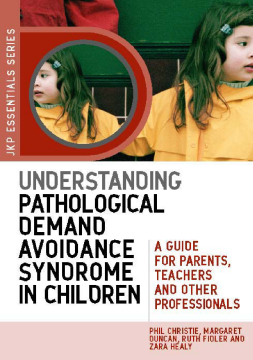
BOOK
Understanding Pathological Demand Avoidance Syndrome in Children
Margaret Duncan | Zara Healy | Ruth Fidler | Phil Christie
(2011)
Additional Information
Book Details
Abstract
This straightforward guide offers a complete overview of Pathological Demand Avoidance Syndrome (PDA) and gives practical advice for overcoming the difficulties it poses in a wide range of contexts from diagnosis through to adulthood.
Starting with an exploration into the background of PDA that answers many of the immediate questions triggered when a child is first diagnosed, the book goes on to look at the impact of the condition on different areas of the child's life and what can be done to help. The authors present useful information on early intervention options and workable strategies for managing PDA positively on a day-to-day basis. They also examine ways to minimize common difficulties that may be encountered at home and school, making life easier for the child, family and peers. The final chapters tackle new problems that can arise when the teenage years hit and how to assist a successful transition from adolescence to adulthood. Illustrative case examples are included throughout, and the book concludes with a list of valuable resources for further information and advice.
Full of helpful guidance and support, this user-friendly introductory handbook is essential reading for anyone caring for, or working with, children with PDA.
Phil Christie is Director of Sutherland House Children's Services, run by autism charity NORSACA (www.norsaca.org.uk), and leads a team of Consultant Child Psychologists at the Elizabeth Newson Centre. The centre carries out training and research activities and has particular expertise in PDA. He is also Associate Editor of 'Good Autism Practice', and became Chair of the Advisory Council of the Autism Education Trust in 2009. Margaret Duncan is a GP and is a parent to a child with PDA. She coordinates the PDA Contact Group (part of Contact-A-Family), an internet based group providing information and support for parents and professionals. Ruth Fidler is Assistant Head Teacher at Sutherland House School run by the autism charity NORSACA. She works throughout the school (aged 3-19) developing whole school approaches to working interactively with children across the autism spectrum, with a particular focus on social and emotional well being. Zara Healy is a parent of a child with PDA. She trained as a journalist and worked for the BBC for nearly a decade as a radio and television reporter.
[This book] written by professionals and parents, it is highly accessible, illustrated by a wealth of case studies and provides practical strategies and approaches covering both the home and school context for managing children with PDA. In terms of addressing the underlying anxiety-driven need of these children, there is a useful section on developing emotional well-being and self-awareness in children with PDA. This book provides a very useful overview and practical resource which all educational psychologists should find helpful
Debate
Pathological Demand Avoidance Syndrome, as a sub-group on the autism spectrum, is now recognised, as are the implications for management and support, particularly in education settings. This book is invaluable in helping parents and professionals identify, understand and support this very complex group.
Dr Jacqui Ashton Smith, Principal, Helen Allison School, National Autistic Society
This book is a useful addition to the literature available on understanding and managing PDA in children and will be an excellent resource for those working and living with children with PDA on a daily basis.
Child and Adolescent Mental Health
This book is full of helpful guidance and support for anyone caring for, or working with, children with Pathological Demand Avoidance Syndrome (PDS)... This is a comprehensive, user-friendly introductory handbook that offers practical advice for overcoming difficulties from diagnosis through to adulthood.
Cerebra
Professionals working with children presenting PDA behaviour would be able to use the book as a "bible", since the sub-headings allow access to information quickly and easily... This book offers good guidance, understanding, advice and solutions to parents, teachers and everyone involved with a child presenting PDA.
Special Children
